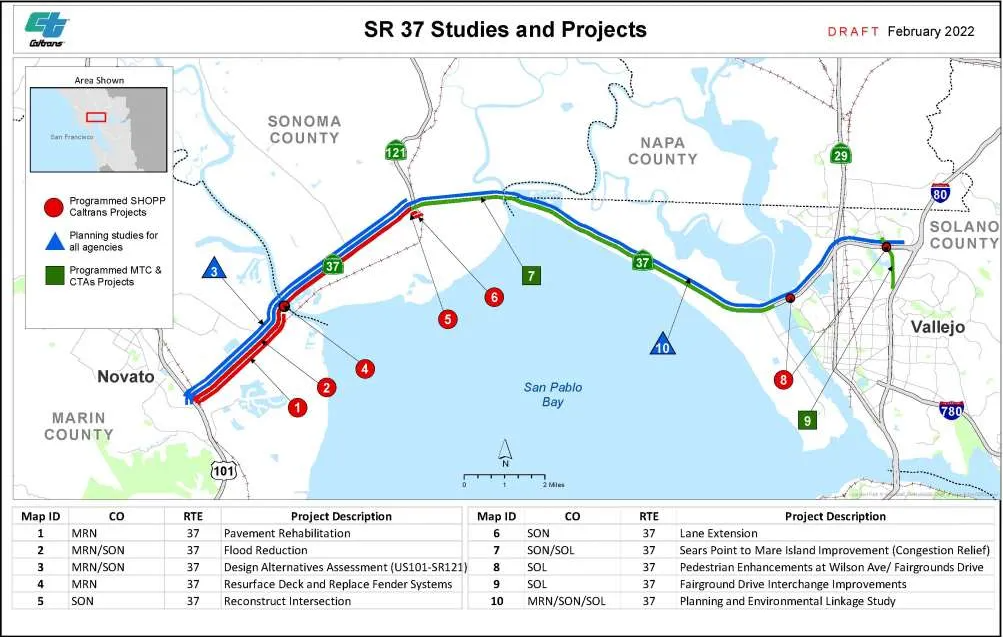Later this week, or perhaps early next, California Transportation Commission (CTC) staff is expected to release the list of projects to be funded by programs created by the Road Repair and Accountability Act of 2017, aka SB1. The grant awards will be finalized at the June 26-27 CTC meeting.
SB 1 program funding is split equally between state and local projects, focusing on road repairs, transit enhancements, and safety improvements. Three of the programs are specifically aimed at reducing congestion, and this year over a dozen of the projects seeking funding in those programs would be used to increase highway capacity.
A coalition of 25 different environmental and smart growth organizations are urging the CTC to reject these projects and focus funding on projects that will reduce the number of car trips and car dependency. Or, in the case of multimodal projects, to only fund the portion of the project that reduces car dependency.
“Our concerns about these projects relate to their inconsistency with the Climate Action Plan for Transportation Infrastructure (CAPTI), their likelihood to significantly increase driving, their environmental, climate, and displacement impacts, and their conflicts with California’s climate and equity goals,” the letter reads.

Solutions for Congested Corridors Program (SCCP)
Of the fifteen projects listed in the letter, five of them have at least some multimodal component that could be funded by the CTC without funding the larger highway expansion. These project applications are all part of SCCP:
- Freedom to State Park Auxiliary Lanes – This auxiliary lane expansion project is a component of the Watsonville-Santa Cruz Multimodal Corridor Project and is opposed by local advocates.
The Santa Cruz Sierra Club wrote a letter supporting some multimodal components in the project that can be built without the lane expansion. These projects include 22 new traffic lights and 10 miles of protected bikeways.
- 101 Multimodal Corridor Segment 4E North – Cabrillo Interchange – This expansion project is a component of the Santa Barbara US 101 Multimodal Corridor Project and was opposed by local advocates. This application for SCCP/TCEP/LPP also has many strong multimodal components that enjoy support from the community and we encourage the CTC to fund these components of this project.
- I-5 Managed Lanes Multimodal Operational Improvements (Orange County) – This project adds 16 lane-miles of new HOV lanes that will exacerbate freeway congestion and air quality issues without a clear commitment to invest in transit alternatives.
Without the new revenue from the lanes being dedicated for transit expansion, the coalition still supports the portion of this project that converts existing HOV lanes to express lanes if those components could be funded separately from the lane expansion components and if toll revenues were committed to providing multimodal alternatives.
- I-15 Express Lanes Project Southern Extension (ELPSE)3 – This project will add over 60 lane-miles to I-15 in a congested and growing region and does not include multimodal and VMT reducing components in Riverside
Many of the same groups signed a letter critiquing the environmental review of this process. They argue the review uses a flawed method for examining the traffic growth that will be created by the project thus underestimating the amount of cars that will be added to the local network and the amount of pollution the project will create.
Streetsblog also wrote about this project last month, and found the environmental documents similarly lacking.
- I-680 NB Express Lane Completion Phase 1 – This express lane expansion project is a component of the Innovate 680 project. Though this SCCP application appears to only be requesting funds for the Shared Mobility Hubs and TDM Augmentation components of the larger project, the coalition still has significant concerns.
In a separate letter, TransForm details concerns with the environmental documents prepared for the I-680 project including: That the DEIR did not consider a reasonable range of project alternatives; a flawed methodology for the transportation analysis has vastly underestimated induced VMT from the project; the underestimation leads to not understanding the project’s impact on air quality; and the VMT mitigation is inadequate.
Another program opposed by the coalition in the SCCP is the SR 37 Sears Point to Mare Island Improvement Project – Phase 2. Earlier this spring, Streetsblog wrote about the many deficiencies with this $500 million project. The worst parts of it are the fact that it would slam a highway through protected wetlands and that because of climate change and its nearness to the shore, the sea-level project could be underwater less than a decade after it is completed.

Trade Corridor Enhancement Program (TCEP)
After first noting that the state has more non-highway expansion projects than in past years, the coalition goes on to warn against funding eight different projects in their entirety. One of the projects has multimodal components worthy of being supported if they can be uncoupled by the highway widening.
- SR 60/World Logistics Center Pkwy Interchange – This project entails a significant expansion and new connection for an existing interchange that will open up land for more warehouse and sprawl development and induce significant new passenger VMT.
- Konocti Corridor – Segment 2B – This project will add 16 general purpose lane-miles to convert the existing conventional highway between Kelseyville and Clear Lake to a four lane expressway and will induce passenger VMT.
- Tulare SR 99 Corridor and Paige Avenue Multimodal Interchange Enhancements – The project adds a general purpose lane to SR 99, which will induce significant passenger and truck VMT. The project as approved further separates South City of Tulare and the neighboring unincorporated community of Maheny Tract by providing the transportation system for the growth of the City’s industrial zones which separates the aforementioned communities.
- State Route 46 Antelope Grade Corridor Improvements Project – This project will add five general purpose lane-miles to convert the existing conventional highway over Antelope Grade to a four-lane expressway and induce passenger VMT.
- State Route 132 Phase 3A Project – This project will add 14 new general purpose lane miles to extend a new expressway that creates a bypass for SR 132 and opens up new land for warehouse and sprawl development and induces new passenger VMT.
- State Route 71 Gap Closure Phase 2 Project – This project will convert an existing arterial highway into an eight-lane freeway, adding a general purpose and HOV lane in each direction. While the advocates do not support the highway lane addition portions of this project, they do support the components that would add sound walls and noise mitigation, update rail bridges to current standards, and enhance a pedestrian overcrossing.
- SR 46 East/Union Road Intersection Improvements – This project entails a new interchange that will open up land for sprawl development and induce significant new passenger VMT.
- 680/SR-4 Interchange Improvement – This project will add a direct connector with two general purpose lanes to the interchange of I-680 and SR-4 without mitigation for increases to passenger VMT.
Local Partnership Program (LPP)
Speaking of the LPP, in addition to the aforementioned Freedom to State Park Auxiliary Lanes, 101 North – Cabrillo Interchange, SR-37, I-15 Express Lanes Project, 101 Multimodal Corridor Segment, 680/SR-4 and State Route 71 Gap Closure programs which are seeking funding in the LPP as well, the coalition highlighted one other project to be rejected.
- Madera 41 South Expressway Project – This project will add eight general purpose lane-miles to convert the existing conventional highway to a four-lane expressway, increasing access to land that is rapidly converting to sprawl development and significantly increasing passenger VMT.

